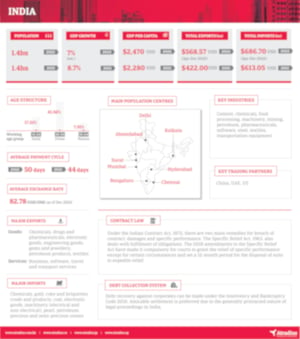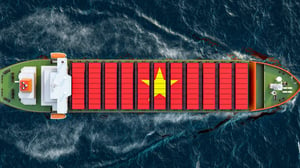
%20(1)%20(1)-1.png?width=1335&name=MicrosoftTeams-image%20(30)%20(1)%20(1)-1.png)
Trade in Asia – India
Insights
India: A Resilient and Rising Economic Power
India defied a difficult 2022, growing the fastest among the world’s major economies and surpassing the UK as the world’s fifth-largest economy. With strong macroeconomic fundamentals, robust foreign exchange reserves, and financially healthy banking and corporate sectors, India faced recent external shocks from a position of strength not seen in years. This offered policymakers greater flexibility to navigate surging commodity prices in the first half of 2022 and the inflationary pressures and monetary tightening cycle that followed.
On the other hand, the long tail effect of the aggressive rate hikes by other major central banks could yet stifle India’s growth momentum in the near term as demand for exports weakens.
However, over the long run, India’s structural advantages — favourable demographics with a large pool of young, well-educated workers, a growing middle class, a relatively low-cost base, an open economy and political stability — will anchor its growth prospects.
India at a glance

State of the economy
While India’s economy has become increasingly integrated with the global economy, it continues to be driven by domestic factors. Domestic consumption and investments fueled India’s hearty growth in 2022. Pent-up demand carried over from the pandemic continued to boost private consumption, and the government’s infrastructure push saw real gross fixed capital formation grow by double digits.
Still, the far-reaching effects of the war in Ukraine has not spared India, which is a large commodities importer, particularly of petroleum products. As prices surged, so did the pressure on India’s fiscal and current account deficit positions, which tend to widen during periods of commodity price volatility as government spending on domestic subsidies increases and more expensive imports outstrip export revenues.
Robust foreign exchange reserves, which stood at over USD 560 billion at the end of 2022, strong inward remittances and demand from overseas for the country’s vaunted IT services helped cushion the impact on the current account deficit.
Meanwhile, the Reserve Bank of India’s calibrated approach to monetary tightening ensured that companies continued to have access to credit to support economic activities. With the banking system holding better quality assets as a result of recent reforms, credit growth for commercial banks stayed at double digits despite the rate hikes. Credit to the industrial sector surpassed pre-Covid levels, with notable increases in the metal products and construction sectors. Housing loans also picked up.
__________________________________
With the banking system holding better quality assets as a result of recent reforms, credit growth for commercial banks stayed at double digits despite the rate hikes.
_________________________________
Crucial to India’s resilience today are the various business-friendly financial reforms and initiatives implemented over nearly a decade by the Narendra Modi-led government. These include the insolvency and bankruptcy reforms that helped Indian banks clean up bad debts and recapitalise, resulting in stronger balance sheets; the population’s growing access to financial services; the Aadhaar biometric ID system; the rapid adoption of digital payments; the large-scale conversion of static household savings into productive investments; the opening up of industries (such as aerospace) previously restricted to foreign investors; and the Make in India push to strengthen the country’s manufacturing sector.
Furthermore, India is well positioned to take advantage of opportunities arising from global disruptions, particularly the supply chain pivot from China. For instance, in a ground-breaking move, Apple began producing the latest iPhone in India in 2022, which, until then, had been solely produced in Chinese factories. Foreign direct investments continue to make their way into India, with inflows primarily going into manufacturing, computer services, automobile, trade and financial services sectors.
Government incentives to encourage companies to manufacture and assemble products in the country, such as the Production-Linked Incentive Schemes, ongoing infrastructure investments and free trade agreements with major markets offer India a leg up against other Asian economies competing to attract the same global brands.
Challenges and risks
In the near term, global economic volatility will continue to test India’s domestic resiliency. A recession in India’s major trading partners poses problems for Indian exporters and their supply chains.
Weaker external demand may require companies to implement tighter cash and credit risk management. Companies in India have been offering trade on credit or allowing greater payment flexibility to support and retain customers. However, there has been a notable deterioration in days-sales-outstanding, according to the Atradius Payment Practices Barometer, and 2022 saw an increase in defaults or bad debts, particularly in the consumer durables sector, which experienced supply disruptions.
Although there is ample liquidity in the financial system, some companies may still experience episodic cash constraints. Indian companies’ ability to harness their balance sheet assets, such as converting account receivables into cash, will be critical to fund expansion and innovation, and remain competitive in global markets. In order to cope with these factors, companies are increasingly turning to global solutions providers for debt collection and trade credit insurance solutions to protect their business viability and liberate cash for investments.
.png?width=6000&height=3500&name=MicrosoftTeams-image%20(29).png)
From the perspective of foreign companies seeking to establish manufacturing centres in India, gaps in the country’s manufacturing ecosystem could pose a challenge, for example, in transporting goods faster to market. While significant advances have been made in the transport system in recent years, first- and last-mile logistical connectivity issues remain. Higher value-added manufacturing activities may also face a shortage of workers with the right skills, which may require companies to invest in training, which will add to labour costs.
Despite improvements in its global ease of doing business ranking, bureaucratic delays remain common in India. Courts may take longer to decide on contract enforcement disputes than in developed markets, delaying major capital allocation decisions. Companies finding themselves in this dilemma may benefit from partnering with organisations that can advise on local regulations and with significant on-the-ground experience in dispute settlement. Amendments to business-related national laws require parliamentary consensus, which may take years to reach.
Economic outlook
%20(1)%20(1).png?width=730&height=411&name=MicrosoftTeams-image%20(28)%20(1)%20(1).png)
While GDP growth is likely to moderate to above 4% in 2023, India will remain a bright spot in the global economy. Its growth will continue to outpace that of developed economies and the global average and the country’s leading export industries – IT and pharmaceuticals – are expected to remain resilient, with the former expected to grow 19% in 2023.
Some tailwinds on the domestic front will come from the government’s planned ramp up in infrastructure spending, which should have a multiplier effect throughout the economy. Stabilising global commodity prices and signs of moderating inflation should also pave the way for the central bank to exit its rate tightening cycle sooner than other markets.
Over the long term, India’s economic ascendancy is expected to be sustained by several structural advantages: the scale of a market of 1.4 billion people, with a growing population of young, educated and tech-savvy workers, an expanding middle class, relatively low production costs, political stability and a market-oriented economy.
As India’s global relevance grows, so will opportunities across its industries. Businesses can position themselves to flourish alongside the world’s next “engine of growth” by having a clear-eyed growth strategy, including relying on local expertise to manage business-critical issues such as trade credit risk, in order to navigate the typical challenges of operating in a rapidly expanding emerging market, and stay ahead of the curve.
This article was produced with the help of insights from the following Atradius experts: Arun Soundarajan, Country Manager, India; Karishma Suvarna Gadia, Commercial and Sales Head, India; and Meghna Nair, Head of Risk Services, India.
All content on this page is subject to our Disclaimer, available here.

